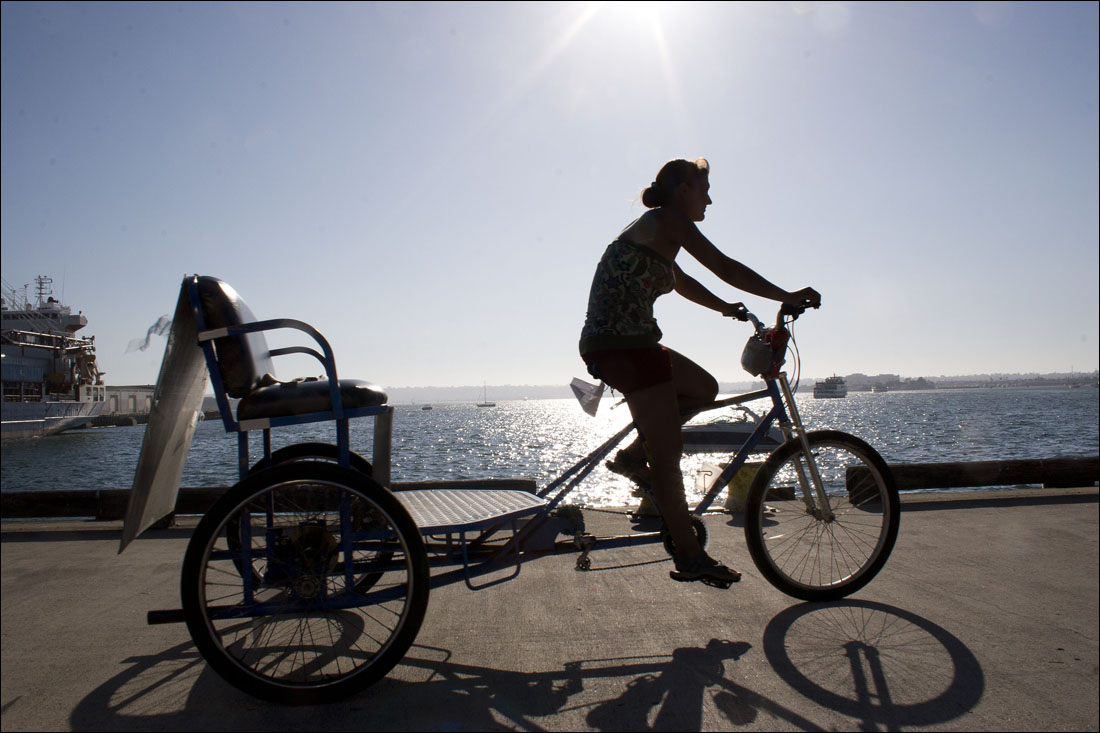
DOWNTOWN — Those who are familiar with Santa Monica's streets know that at certain times of the day it can be frustrating to get from point A to point B.
Now consider commuting with pedicabs added to the mix of buses, cars, bikes and pedestrians.
City officials are currently studying how best to regulate the pedal-powered taxis after a company in June called Trike Pilots Inc. applied for a business license to operate five to eight pedicabs initially, with the ultimate goal of having 20 ferry locals and tourists from Main Street to Montana Avenue.
There are those who feel pedicabs could add to traffic congestion since they are treated just like bicycles and are required to travel in the roadway and along bike paths. Others believe that if regulated properly, including having drivers pass background and drug tests, purchase insurance and install seat belts, the pedicabs could be a great novelty that would get people out of cars and possibly cut down on the amount of vehicle traffic on the streets.
"Santa Monicans have said that traffic circulation is their number one issue and it's hard to see how pedicabs could help alleviate any of the traffic," said Kathleen Rawson, CEO of Downtown Santa Monica Inc., the public-private management company that oversees Downtown and advises the City Council on issues that impact businesses and residents in the area. "It's a complex issue that has to be studied. We are open minded, but there are some significant safety concerns as well."
Currently 45 major U.S. cities have pedicabs for hire, usually in downtowns, convention and resort areas, said Sam Morrissey, City Hall's traffic engineer. Several of those cities have chosen to regulate them to varying degrees, ranging from the simple adherence to the California Vehicle Code, which requires operators to have a valid driver's license and complete a bicycle safety course, to capping the number of pedicabs and setting fares.
Tighter restrictions bring more oversight, which could include more work by police officers and city officials, Morrissey said. City Attorney Marsha Moutrie told the City Council during a discussion on the issue last week that adding more restrictions could lead to legal battles. She said since pedicabs are considered bicycles under the vehicle code, there could be little that the council could do when it comes to designating certain routes or times of day to operate.
"I don't think state law is where you are," she said to the council. "I think state law needs to catch up with reality. It's not even clear to me that the city has the legal authority to tell a pedicab where it can't go … ."
The council did create a one-year pilot program in 1998, but no company set up shop during that time and the council let the program expire. Los Angeles is currently looking at the best ways to regulate and is considering setting up a pilot program in Hollywood.
Daniel Kerrigan, owner and operator of Texas Trike Pilots, a pedicab company in Austin, Texas, said there are solutions to Santa Monica's concerns, such as using alleys to get pedicabs off congested, narrow streets, like those found in Downtown. He said pedicabs provided a great service to those looking to hop from one restaurant or bar to another and not worry about driving.
"There are 534 pedicabs registered in the city of Austin, and there are no problems," he said.
Santa Monican Jenna Linnekens, vice chair of the Recreation and Parks Commission, told the council that she personally feels that if regulated properly, the cabs could help City Hall in its goal of getting more people out of their cars. However, she's not keen on the idea of having them ride along the heavily-used bike path.
"I want to make sure the bike path down on the beach doesn't become the 405 Freeway," she said, citing concerns about safety.
The National Safety Council, in studying the safety of pedicabs, conducted a review of admission to a level one trauma center in San Diego from 2000 to 2009. The review showed 15 major trauma victims injured in pedicab accidents, 14 of whom had fallen from the pedicab, according to a report by city transportation engineers. Alcohol was detected in 10 of the 14 victims. Eleven of the 15 experienced traumatic brain injury, skull fracture, or loss of consciousness. Two died due to severe traumatic brain injury.
While the study found that injuries were mostly due to falling from the pedicab in the evening hours while drunk, one of the two deaths occurred when the victim, who was not intoxicated, fell from the pedicab as it was making a sharp turn. At the time of the accident, pedicabs in San Diego were required to have seat belts, but the one involved did not, according to the report.
Most council members seemed in favor of allowing the pedicabs, but with restrictions to ensure safety and lessen the impact on traffic.
Councilman Bob Holbrook, who has ridden pedicabs while attending USC football games in Tempe, Ariz., says they are fun, but he just doesn't see them working in Santa Monica in the same way because the streets aren't wide enough for the cabs, some of which are 4 feet or 5 feet wide.
"I think we have to do it because you can't deny people the right to set up this type of business, but we need to regulate it and make sure there are routes to support them."
kevinh@www.smdp.com









